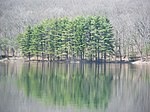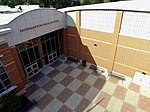Mount Tom Range
Civilian Conservation Corps in MassachusettsGeology of MassachusettsLandforms of Hampden County, MassachusettsMetacomet Ridge, MassachusettsMount Tom Range ... and 2 more
Mountain ranges of MassachusettsVolcanism of Massachusetts

The Mount Tom Range is a traprock mountain range located in the Connecticut River Valley of Massachusetts. It is part of the Metacomet Ridge that extends from Long Island Sound near New Haven, Connecticut, north through the Connecticut River Valley of Massachusetts to nearly the Vermont border. A popular outdoor recreation resource, the range is known for its continuous west facing cliffs and its rugged, scenic character. It is also notable for its unique microclimate ecosystems and rare plant communities, as well as significant historic sites, such as the ruins of the 18th century Eyrie House located on Mount Nonotuck.
Excerpt from the Wikipedia article Mount Tom Range (License: CC BY-SA 3.0, Authors, Images).Mount Tom Range
NET/M&M Trail (white), Holyoke
Geographical coordinates (GPS) Address Nearby Places Show on map
Geographical coordinates (GPS)
| Latitude | Longitude |
|---|---|
| N 42.241666666667 ° | E -72.648055555556 ° |
Address
WGBY-TV (Springfield)
NET/M&M Trail (white)
01040 Holyoke
Massachusetts, United States
Open on Google Maps







